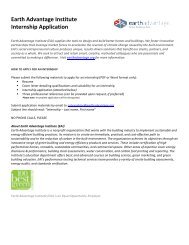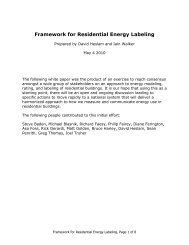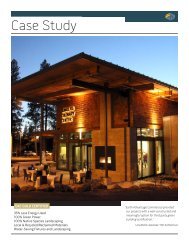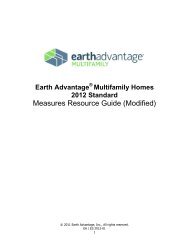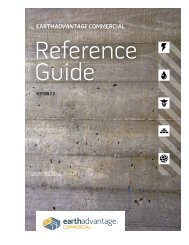EA New Homes Measures Guide - Earth Advantage
EA New Homes Measures Guide - Earth Advantage
EA New Homes Measures Guide - Earth Advantage
You also want an ePaper? Increase the reach of your titles
YUMPU automatically turns print PDFs into web optimized ePapers that Google loves.
2012 <strong>Earth</strong> <strong>Advantage</strong> Residential<br />
<strong>Measures</strong> Resource <strong>Guide</strong><br />
5.1.3<br />
Balanced System - Exhaust and supply balanced w/o heat recovery.<br />
Energy<br />
Materials<br />
Water<br />
0 2 0 1 0<br />
Description: There are several different ways to create a balanced ventilation system without heat recovery. In all cases, exhaust fans<br />
installed in the living area must be ENERGY STAR labeled. Remote-mounted fans in attics, crawlspaces, garages do not require ENERGY<br />
STAR labels, but should be selected for low-energy, quiet operation. <br />
<br />
Option 1: Using an inline supply air fan and a branched duct system to DELIVER fresh air to multiple locations (typically bedrooms.) A<br />
single exhaust fan shall be wired to the same circuit to operate simultaneously with the supply fan. A 24 hour programmable timer must<br />
control the system to meet ASHRAE 62.2 <br />
<br />
Option 2: Using an inline exhaust fan and a branched duct system to REMOVE stale air from multiple locations (typically bathrooms,<br />
laundry or kitchen.) A single low sone inline supply fan shall be wired to the same circuit to operate simultaneously with the exhaust fan.<br />
A 24 hour programmable timer must control the system to meet ASHRAE 62.2 <br />
<br />
Option 3: An integrated exhaust system with multiple exhaust fans plus a passive supply air duct with a mechanically controlled damper.<br />
The supply air duct may connect to the air handler or be the through wall type. The system must have a common controller which can<br />
coordinate the fans with the opening of the supply air duct. The controller must also be programmable to meet ASHRAE 62.2. <br />
<br />
Option 4: In homes with forced air heating systems, a single exhaust fan and a fresh air duct to the air handler are wired to the same<br />
control. This operates the exhaust and supply at the same time to provide balanced ventilation. <br />
<br />
Option 5: An exhaust fan with adjustable air flow rate set to ASHRAE 62.2 runs continuously. A supply duct is connected to the air handler<br />
on the return side with a manual damper installed. The damper shall be adjusted so that the flow rate is set to ASHRAE 62.2 when the air<br />
handler is running at high speed. <br />
<br />
Option 6: An exhaust fan is installed in a central location. A supply duct is connected to the air handler on the return side with a motorized<br />
damper installed. An adjustable damper is set to allow the air flow rate to be set to ASHRAE 62.2. The exhaust fan, motorized damper and<br />
furnace blower are all connected to the same 24-hour timer set to run 10 minutes each hour.<br />
Health<br />
Land<br />
Benefit: This fresh air ventilation system removes stale indoor air and also supplies fresh outdoor air. This improves the indoor air quality<br />
of the home. This system can improve the indoor air quality of the house by mixing fresh air from outside. Balancing supply and exhaust<br />
provides better ventilation while reducing the potential for pressure imbalance inside the home.<br />
Verification: <strong>EA</strong> Rater will engage the system to ensure that the exhaust and supply are operating simultaneously. Rater will verify the<br />
Supply air is routed from outdoor sidewalls, gable end wall, or soffit vent (with sealed ductwork to the exterior so no attic air can be drawn<br />
in.)<br />
5.1.4<br />
Spot HRV/ERV<br />
Energy<br />
Materials<br />
Water<br />
0 2 0 1 0<br />
Description: One spot HRV/ERV per approximately 1000 sq ft is required in order to have sufficient ventilation capacity. HRVs and ERVs<br />
typically operate continuously on a low speed. Some have the ability to boost flow when more ventilation is needed. These may be used in<br />
place of local ventilation in bathrooms, provided they deliver enough ventilation at high speed to meet local ventilation requirements.<br />
Health<br />
Land<br />
Benefit: HRVs and ERVs are considered the premium ventilation systems. They are highly effective and reduce the energy penalty<br />
associated with all fresh air ventilation. By tempering incoming air, these units provide greater comfort in extreme climates than other<br />
types of ventilation systems.<br />
Verification: <strong>EA</strong> Rater will engage the system to ensure that the exhaust and supply are operating simultaneously. Rater will verify the<br />
Supply air is routed from outdoor sidewalls, gable end wall, or soffit vent (with sealed ductwork to the exterior so no attic air can be drawn<br />
in.)<br />
Page 41 of 70



